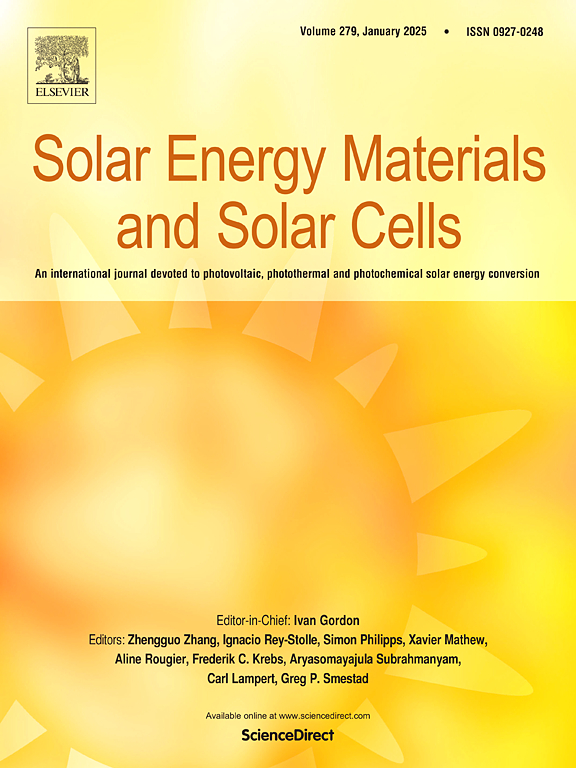Quantitative study of hot carriers thermalization mechanisms in GAx[Cs0.05(FA0.23MA0.77)0.95]1-xPbIBr2 for hot carrier multi-junction solar cells
IF 6.3
2区 材料科学
Q2 ENERGY & FUELS
引用次数: 0
Abstract
The hot carrier multi-junction solar cell (HCMJSC) is an advanced concept solar cell with a theoretical efficiency greater than 65 %, which consists of a thin top junction with a wide bandgap and a thick bottom junction with a narrow bandgap to absorb high and low energy photons, respectively. Wide bandgap perovskites are expected to be a suitable candidate for top absorption layers due to their ease of band engineering. However, the carrier thermalization mechanisms of quaternary A-site perovskites have not been well studied until now. Conventionally, the incorporation of larger A-site cations induces lattice expansion and enhances thermal fluctuations, thereby accelerating carrier cooling. In this work, the incorporation of guanidinium (GA) did not immediately shorten the cooling process but instead exhibited a non-monotonic trend, initially slowing then accelerating the thermalization process. The thermalization coefficients (Qth) of the quaternary A-site perovskites with different GA doping ratio were obtained from the power dependent-steady state photoluminescence spectra. Moderate addition of GA can prolong the thermalization process of the hot carriers and reduce Qth, which will improve power conversion efficiency, with the optimal effect achieved at 3 % GA incorporation in the A-site. This work lays the foundation for a theoretical framework that incorporates perovskite materials which may be suitable as the top absorption layer of HCMJSC.
热载流子多结太阳能电池GAx[Cs0.05(FA0.23MA0.77)0.95]1-xPbIBr2中热载流子热化机理的定量研究
热载流子多结太阳能电池(HCMJSC)是一种理论效率大于65%的先进概念太阳能电池,它由宽带隙的薄顶结和窄带隙的厚底结组成,分别吸收高能量光子和低能光子。宽带隙钙钛矿由于其易于带工程,有望成为顶部吸收层的合适候选者。然而,迄今为止,对四元a位钙钛矿的载体热化机理还没有很好的研究。通常,加入较大的a位阳离子会引起晶格膨胀并增强热波动,从而加速载流子冷却。在这项工作中,胍(GA)的掺入并没有立即缩短冷却过程,而是表现出一种非单调趋势,最初减缓然后加速热化过程。通过功率依赖稳态光致发光光谱,得到了不同GA掺杂比的四元a位钙钛矿的热化系数Qth。适量添加GA可以延长热载流子的热化过程,降低Qth,从而提高功率转换效率,其中GA在a位添加3%时效果最佳。这项工作为钙钛矿材料的理论框架奠定了基础,钙钛矿材料可能适合作为HCMJSC的顶层吸收层。
本文章由计算机程序翻译,如有差异,请以英文原文为准。
求助全文
约1分钟内获得全文
求助全文
来源期刊

Solar Energy Materials and Solar Cells
工程技术-材料科学:综合
CiteScore
12.60
自引率
11.60%
发文量
513
审稿时长
47 days
期刊介绍:
Solar Energy Materials & Solar Cells is intended as a vehicle for the dissemination of research results on materials science and technology related to photovoltaic, photothermal and photoelectrochemical solar energy conversion. Materials science is taken in the broadest possible sense and encompasses physics, chemistry, optics, materials fabrication and analysis for all types of materials.
 求助内容:
求助内容: 应助结果提醒方式:
应助结果提醒方式:


